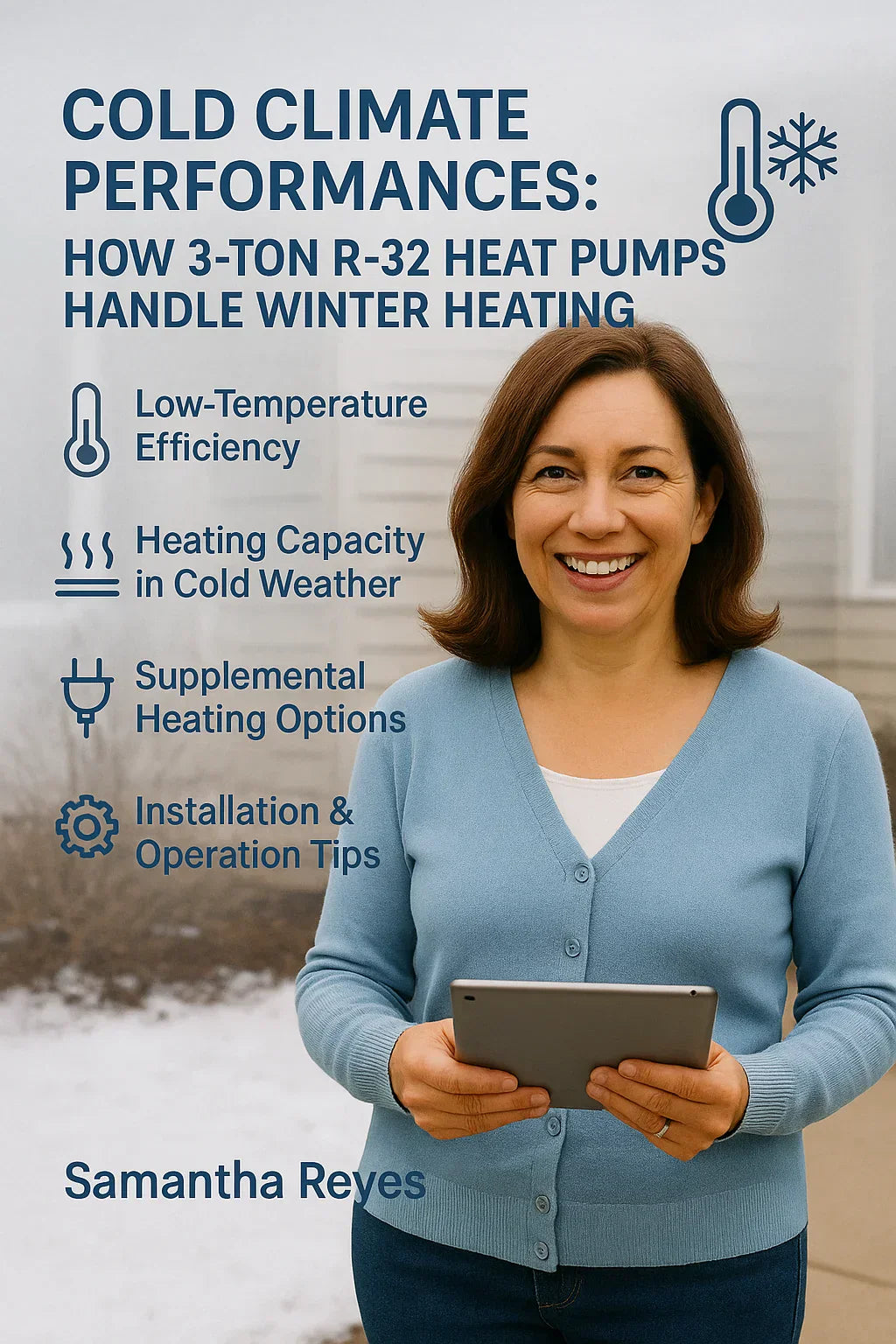💬 Introduction: R-32 in the Dead of Winter
I still remember the first real test for my R-32 heat pump. It was late January, the temperature outside was hovering around 12°F, and my neighbor’s old unit was chugging along with the backup electric coils running full-time. Mine? Quietly humming away, keeping the house a steady 70°F without kicking into auxiliary heat.
That’s when I realized: not all heat pumps are created equal in cold climates, and R-32 systems—especially the 3-ton models—are surprisingly good at keeping up when the mercury drops.
This guide will break down why R-32 works so well in cold weather, what performance numbers you should care about, and how to get the most out of your system when the snow starts flying.
🌡️ How R-32 Handles Cold Temperatures
Most homeowners know refrigerants as “that thing inside the AC” but in heating mode, refrigerants are the heart of the system.
Better Heat Transfer
-
R-32 has a higher volumetric capacity and better heat transfer efficiency than R-410A..
-
This means it can absorb more heat from cold outdoor air before it hits the compressor.
Lower Pressure Ratio at Low Temps
-
In freezing weather, compressors work harder. R-32 maintains a more favorable pressure ratio, reducing strain and keeping efficiency up
Capacity Retention
-
Many 3-ton R-32 heat pumps retain 70–80% of their rated heating capacity even at 17°F, and some high-performance models keep 60%+ at 5°F (Energy Star Cold Climate Heat Pump List).
📊 Performance Metrics You Should Know
If you’re comparing cold-weather performance, focus on these numbers:
HSPF2 (Heating Seasonal Performance Factor)
-
Tells you how efficiently the heat pump runs over an entire heating season.
-
Cold climate models should have HSPF2 ≥ 8.5.
COP (Coefficient of Performance)
-
Measures how many units of heat you get for each unit of electricity used.
-
A COP of 2.0 at 17°F means you’re getting twice as much heat as the electricity you’re paying for.
Capacity Retention %
-
Indicates how much of its heating output a heat pump can maintain at low temperatures.
-
Look for models that keep ≥70% capacity at 17°F.
🔌 Supplemental Heating: Do You Still Need It?
Even the best R-32 heat pumps can benefit from a backup plan in extreme cold.
-
Heat Strips – Electric coils that kick in when the heat pump can’t meet demand.
-
Dual Fuel – Pairing your heat pump with a gas furnace for sub-zero days.
Good news:
With R-32 and inverter-driven compressors, many homes in moderate cold climates only need auxiliary heat a handful of days a year.
🛠️ Cold-Climate Installation Tips
Your R-32 heat pump’s winter performance isn’t just about the refrigerant—it’s also about how it’s installed.
-
Outdoor Unit Placement
-
Elevate the unit 12–18 inches off the ground to prevent snow blockage.
-
Keep at least 2–3 feet clearance on all sides for airflow.
-
-
Snow & Ice Protection
-
Install a simple overhead cover to protect from falling ice and heavy snow accumulation.
-
-
Drainage & Defrost
-
Ensure the unit drains away from walkways (no one likes a sheet of ice in front of the porch).
-
Choose a model with an efficient defrost cycle to prevent frost buildup.
-
-
Certified R-32 Installer
-
Because R-32 is an A2L refrigerant (mildly flammable), your contractor must be certified to handle it (AHRI A2L Safety Guidelines).
-
💰 Energy Costs & Savings in Winter
A well-installed 3-ton R-32 heat pump can cut winter heating costs by 20–40% compared to electric resistance heating.
Example Cost Comparison (2,000 sq ft home, Zone 5, 3-month heating season)
| System Type | Avg Monthly Winter Bill | Seasonal Total |
|---|---|---|
| Electric Resistance | $350 | $1,050 |
| R-410A Heat Pump | $220 | $660 |
| R-32 Heat Pump | $185 | $555 |
Savings vary by climate, utility rates, and home insulation, but R-32 consistently outperforms R-410A in cold conditions.
🌎 Environmental Benefits in Winter
Choosing an R-32 system isn’t just about performance—it’s about reducing your footprint.
-
Lower GWP (~675 vs. 2,088 for R-410A) means a smaller climate impact (EPA AIM Act).
-
Less refrigerant volume required per system.
-
Meets upcoming EPA and DOE low-GWP targets years ahead of deadlines.
🧰 Samantha’s Winter Heating Checklist
Before the first frost hits, here’s what I recommend:
-
✅ Schedule a pre-season tune-up to check refrigerant charge, filters, and coil condition.
-
✅ Clear vegetation and ensure proper drainage around the outdoor unit.
-
✅ Set a consistent thermostat schedule—don’t let the system cycle wildly.
-
✅ Check auxiliary heat settings—make sure they’re set to kick in only when necessary.
💬 Closing Thoughts
If you live in a colder climate, a 3-ton R-32 heat pump is a smart choice—it delivers steady, efficient heat well below freezing, keeps operating costs in check, and reduces your environmental impact.
For me, switching to R-32 has meant fewer cold spots, lower bills, and no more dreading my winter electric statement.
With the right installation and a little seasonal care, you can enjoy cozy comfort even when the thermometer says otherwise.
External Links Used
In the next topic we will read about: How to Maintain Your 3-Ton R-32 Heat Pump for Maximum Lifespan







